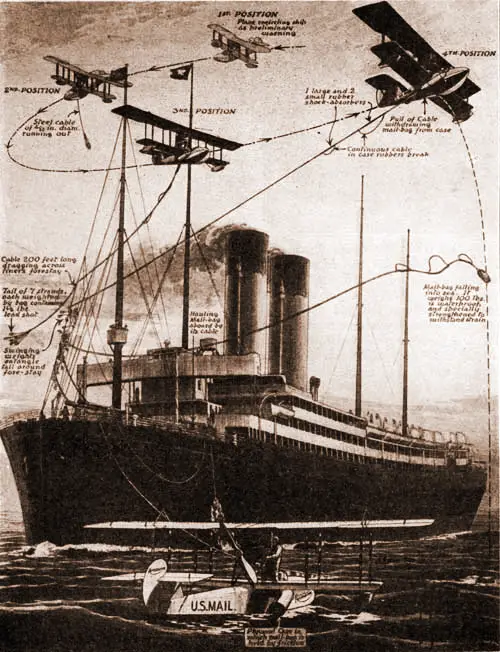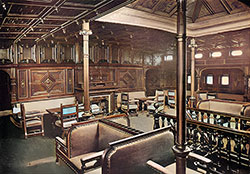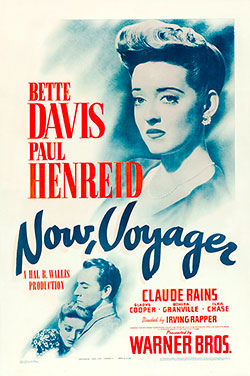Interesting Facts (And Factoids) About Steamships
From the glamour of Hollywood to the technology of submarine signaling, steamships have generated fascinating stories beyond simple passenger travel. This section gathers unusual and often overlooked “factoids” about ocean liners and their role in culture, engineering, and society.

Aerial Mail at Sea - 1920 - How Mail is Dropped on Liners by Airplanes. Illustrated World, April 1920. | GGA Image ID # 1fa84baee3
🚢 Life Onboard & Passenger Comfort

Steamship Barbers and Barber Shops (1880s–1910s)
Onboard barber shops offered shaves, haircuts, and souvenirs—selling mounted photographs of the ship to eager travelers. From French luxury liners with elegant salons to Inman Line vessels with conversational barbers, these shops were both practical and social hubs at sea.
Read More »

Gambling on Ocean Liners (1890)
First-class smoking rooms on transatlantic liners often doubled as gambling halls. Professional card sharps and wealthy travelers wagered on everything from poker hands to the ship’s daily run. This 1890 account by Captain Charles W. Kennedy of the SS Germanic exposes how tolerated—and profitable—gambling was for steamship companies. 🎲🚢 Read More »
Quick Links to Interest Facts About Steamships, Etc.
- Steamship Fun Facts, Interesting Factoids
- 1889 Night Signals of Transatlantic Steamships
- 1889 Safety on the Ocean
- 1889 Schedule of Time Across the Atlantic
Quickening the Time It Takes to Cross the Atlantic - 1889 Steamship Barbers and Barber Shops
- 1889 Steamship Bell Time - Crew Watch Shifts
- 1905 Submarine Signaling on Steamships
- 1906 Remarkable Achievement of the Submarine Signal Apparatus
- 1920 Aerial Mail At Sea
How Mail is Dropped on Liners by Airplanes - 1922 Federal Documents Requried for Ocean Carriers
- Most Popular Steamships - Top Ten Rankings 1880s to 1954
- c1935 Classes of Ships
- 🎬 Hollywood at Sea: Ocean Liners in Film
Night Signals of Principal Transatlantic Steamship Lines - 1889
To make themselves know to other ships, the transatlantic steamships adopted a system of lights specific to their line that identified the steamship line to an approaching vessel.
Safety on the Ocean - 1889 Article Discusses the Advances Made
REFORM, progression, and common sense are vital characteristics in steamship commanders of the present day, when huge racers are multiplying, and consequently the necessity of being keenly on the alert cannot be too strongly emphasized. There cannot be too many precautions taken by those who hold full sway on the bridge of the ocean greyhounds; too many safeguards cannot be thrown about the lives of those who trust blindly to the skill and efficiency of those in authority.
Schedule Time Across The Atlantic - Quickening the Time It Takes to Cross the Atlantic - 1889
LONDON to New York in four days and nineteen hours ! Is it feasible or even probable ? Well, yes; OCEAN thinks it is, and that it is only a question of time, in view of what has already been accomplished in the matter of reducing the record across the Atlantic. So strong is the faith of practical men and capitalists in this scheme, that it is whispered in business circles that a syndicate proposes shortly to test the feasibility of the route.
Gambling on Ocean Liners (1890)
Among the better class of travelers who yearly cross the ocean, the question has repeatedly arisen, and very naturally too. Why Is It that gambling is so openly allowed and so openly encouraged, as it unquestionably is, by the steamship companies in the smoking-rooms of the first-class Atlantic steamers?
The Compound Engine (1896)
In the simple engine, the steam passed at low pressure from the boilers to the cylinder, where it did its work, and then passed direct to the condenser. However, in the compound it passes at very high pressure into a small cylinder and thence by expansion into a large one, and thence, in the triples, to a still larger one, before it passes into the condenser.
The Evolution of Twin Screws on Steamships (1896)
The City of New York, of the Inman and International line, in 1888 adopted twin screws, but she was by no means the first to do so. In fact, they were tried by Stevens, on the Hudson, in a small boat as far back as 1804, but she failed because, it is said, he could not make the stern pipes tight. Ericsson, too, tried them in a very ingenious way, on one shaft, in the F. B. Ogden, on the Thames in 1836, with great success. However, the City of New York was the first of the North Atlantic passenger fleet to adopt them.
Steamship Barbers and Barber Shops (1899)
BARBERS on some of the favorite ocean steamships do quite a lucrative business selling the photographs of the vessel. The pictures are mounted in different sizes, and are sold at a trifle beyond ordinary price.
Steamship Bell Time and Crew Watch Shifts - 1889 Ocean Liners
Transatlantic Steamships kept time using a 24 hour clock and the rang bells at specific intervals. They also had watches, primarily to avoid collision with ocean obstacles like icebergs and other ships. This article from 1899 explains the Bell Time and Crew Watch Shifts.
Submarine Signaling on Steamships (1905)
The success that has attended the introduction of submarine signaling by means of bells underneath lightships, or along the shore, to ships far out at sea, is one of the principal topics now engaging the attention of naval experts the world over, for it is believed that the perfection of this system of communication may be the answer to that most perplexing naval problem of modern times, which is the discovery of a method by which battleships, cruisers, and other war craft may be able to detect the approach of submarine torpedo craft in ample time to locate their position and then to destroy or render them ineffective.
Remarkable Achievement of the Submarine Signal Apparatus (1906)
The Submarine Signal Apparatus installed upon the Express Steamships of the North German Lloyd recently achieved a noteworthy success. The apparatus having long since demonstrated its great value as an aid to navigation, the North German Lloyd have now also equipped their tender "Willkommen," stationed in Cherbourg, France, with the submarine bell to signal approaching vessels.
Flower Store On An Ocean Liner (1907)
Though there are legends of ancient splendor in which voluptuous monarchs are represented as having roses sent to their capitals by the shipload, the modern developments of horticulture, great as they have been, have not yet reached this stage. Yet, those of us who have reach middle life can look back with feelings akin to amazement on the wonderful advancements that have been made in the cut flower and plant trade.
The Print-Shop on the Sea (1907)
While many warships publish papers at sea mainly relating to official duties, they are scarcely regarded as newspapers, and it remained for the Cunard Steamship Company to inaugurate the first daily newspaper ever printed on board ship.
The Subject of Ocean Lanes Used by Steamships (1911)
Commanders of vessels are required not to deviate from these routes, except for the most urgent reasons. Among the objects attained by fixed adherence to established routes are: Prevention of collision between vessels proceeding in opposite directions, more certain and precise knowledge of winds, compass variations, ocean currents and weather conditions along the regular track, and prompt assistance to a ship in case of accident or injury.
Submarine Signaling for Communicating from Shore Stations (1911)
The submarine signal system, for communicating from shore stations, lighthouses and light vessels to approaching steamships in foggy or thick weather, when visual signals are useless, has been adopted by the principal maritime nations. Many stations have already been established on the Atlantic coasts of the United States and Europe, and the system is being rapidly extended to all parts of the world.
The Earliest Steamships (1912)
In the year 1801, a vessel propelled by steam was tried on the Forth of Clyde in Scotland, and this boat seems to have been a success.
Guarding Gold at Sea, Steamships Transport Precious Cargo (1912)
The natural assumption would be that in the safeguarding of the treasure which the various countries are constantly sending one another by the big ocean liners, there would be required the vigilance of many men. This, however, is not generally the case, since once the gold is stored away in the rooms set apart for that purpose on the big ships and the vessel is well out to sea, no armed guards are necessary.
Aerial Mail at Sea - 1920 - How Mail is Dropped on Liners by Airplane (1920)
The above illustration graphically portrays and describes the remarkable feat of an airplane dropping a mail sack on an ocean liner at sea, while both craft are in motion, as performed by Pilot C. J. Zimmerman and a mechanic in a U. S. mail aeromarine boat, when a pouch was delivered to the White Star liner Adriatic.
U.S. Federal Document Required For Ocean Liners and Steamships (1922)
The Steamboat-Inspectiuon Service, by inspecting vessels, boilers and equipment, and the Bureau of Navigation of the Department of Commerce by administering the navigation laws, also promote the safety of navigation, but their work from the standpoint of the vessel owner is mainly regulatory.
Naming of Steamships - The System of Many Shipping Companies Revealed (1922)
In the entire world of shipping there are few subjects at once so interesting and obscure as the systems of nomenclature employed by different owners of vessels. A vast number of craft, of course, are like Chief Sitting Bull: their family connections never would be guessed from their names; but, on the whole, many more companies than is generally supposed employ uniform and distinctive systems.
Deck Wind Shelter for Steamship Passengers' Comfort (1906)
The North German Lloyd has just adopted for their express steamers an ingenious invention, by means of which any number of substantial wind shelters can be provided on deck at a few minutes notice, an addition to passengers' comfort which is certain to be appreciated.
The Art of Naming Ships (1922)
An exhaustive report on how many of the steamship companies named their ships including Cunard, White Star Line, Canadian Pacific, United American Lines, Ellerman's Wilson Line, Prince Line, W. R. Grace & Co., Holland-America Line, Matson Navigation Company, Oceanic Steamship Company, and many others.
The Most Popular Steamships and Steamship Lines 1880s to 1954 - Top Ten Rankings
We are often asked what the most popular steamships and Steamship Lines are. Often it is subjective and sometimes controversial - especially considering the different types of passenger traffic - from ships that concentrated on the Immigrant trade to Luxury Liners.
Other Fun or Interesting Factoids About Steamships
Fun and interesting facts and factoids about steamships, their opertaions and the crew and passengers gleamed from the documents and publications found in the Gjenvick-Gjønvik Archives.
Evolution of the Modern Cruise Liner
This article has been excerpted from a technical paper of the Royal Institution of Naval Architects published in the Naval Architect Journal in May 1990.

🎬 Hollywood at Sea: Ocean Liners in Film
Ocean liners of the 20th century captured the public imagination, symbolizing glamour, power, migration, and adventure. Hollywood seized on these floating cities as backdrops for stories of romance, espionage, and drama. By setting narratives aboard luxury liners, filmmakers combined exotic travel with human drama, creating enduring cinematic moments.
